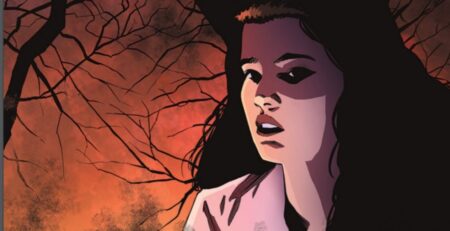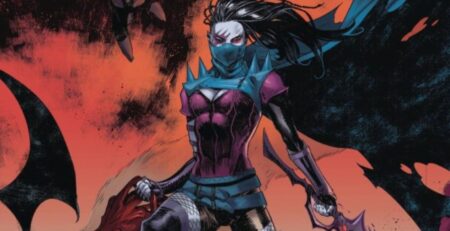
Assassin’s Creed: Bloodstone Vol. 1, published by Titan Comics and originally released as a two-volume graphic novel series written in French by Guillaume Dorison with art from Ennio Bufi, this first volume is translated by Marc Bourbon-Crook. The story focuses on a Japanese hacker, Tomo, trying to investigate his mother’s murder by connecting to an ancestor in the middle of the Vietnam War. The Assassin’s Creed franchise was kickstarted in 2007 by the first eponymous game in the long-running series, Assassin’s Creed. The series centered around a war between two secret orders, the Assassins and the Templars. These games have taken place in several different eras and moments in history. Starting in the period of the Third Crusade, the Assassin’s Creed franchise blossomed within the gorgeous Italian Renaissance before branching out to the worlds of Colonial North America, The French Revolution, and the Sikh Empire in India.
The plot around Tomo in Assassin’s Creed: Bloodstone Vol. 1 is propelled at an ever-shifting and confusing pace. The characters move through different locations in different countries. The events in the past are fascinating, but you’re not in them for as long as you want to be there. These aspects make it difficult for the reader to get a grasp on what’s happening and to gain a relationship with the characters. This is especially true in the middle of the book, where it becomes very hard to maintain a grasp on the different plotlines. Sub-plots and character arcs are also hard to follow and often don’t carry much weight.
Another negative about the plot is the lack of time spent in the Vietnam War. This may be because the majority of this is in the second part of the series, but I found that the thing I was most looking forward to from this book was sparse. Assassin’s Creed, while being a sci-fi game, is also an opportunity to teach the audience about the societal and political situations in the historical eras each game explores. The communities they were in were often on the verge of a revolution, civil war, or a cataclysmic cultural change. Vietnam is one of the most recent examples of an event like the franchise has tackled and the opportunity to explore the themes possible from that setting appears to have been squandered.
The characters are also difficult to build relationships with because of the speed of the plot. The protagonist, Tomo, is so often used to drive to plot forward that there are few moments that allow the audience to get attached to him. His historical counterpart, Alekseï Gavrani, has more identity and is much more interesting to read, as are the other characters involved in that timeline, but as previously mentioned, the reader spends more time with the less fun Tomo.
The art, drawn by Bufi, is beautiful during the slow moments but absolutely comes to life during the action scenes. The feeling of motion and force, when the assassins are at work, is what draw me into this story. This is why I felt like there should have been more of it, to give Bufi a chance to tell the story through movement. And while the globe-trotting aspect of the story can be slightly jarring on the mind, it is exquisite on the eyes. That is helped by the colors by Andrea Meloni. From the blues of the cities to the greens of the jungles, the colors compliment Bufi’s wide panel shots.
Another thing that should be mentioned is the lettering of the word balloons. The close spacing between the letters sometimes makes it difficult to read. In a long book like this where the audience has to read every detail a character says because it will hold importance 30 pages later, it is important that the font is easy for the eye to process. Despite this criticism, it should be added that the SFX is fantastic and makes the audience feel the impact. When bullets are fired, and punches are thrown, the audience can feel it.
This book was difficult to review because a lot of it conjured up the feeling of wanting more. When playing an Assassin’s Creed game, the fascinating part of that world is playing inside that historical landscape. The modern-day aspect and the characters in the present were always an aside I skipped through because I wanted to return to those majestic cities. In Assassin’s Creed: Bloodstone Vol. 1, it feels like the opposite, where the creators wanted to make the audience more interested in the present-day characters, but that wasn’t achieved either. I wanted to spend more time in the Vietnam War era and less time with characters that I didn’t feel anything for. The art carries the story and does attempt to keep you hooked when the reader feels lost. It would be worth collecting the other half of the graphic novel in order to experience more of the fantastic action and for the potential that the plot be clearer after reading both parts.
Assassin’s Creed: Bloodstone Vol. 1 is available where books and comics are sold
Assassins Creed: Bloodstone Vol 1
TL:DR
Assassins Creed: Bloodstone is a beautifully drawn book marred by a plot so confusing the reader would have to travel back in time to figure out.






